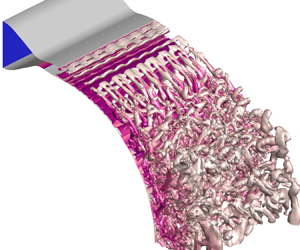Article contents
Numerical study of instabilities and compressibility effects on supersonic jet over a convex wall
Published online by Cambridge University Press: 23 December 2022
Abstract

The supersonic jet over a convex wall is numerically investigated using the delayed detached-eddy simulation method based on the two-equation shear-stress transport model. The current study focuses on instabilities, turbulent statistics and the influence of compressibility effects. A widely applicable data-driven modal decomposition approach, called dynamic mode decomposition is used to gain further insight into the dynamical behaviours of the flow. The results demonstrate that streamwise vortices caused by the centrifugal force play significant roles in shear layer instabilities. The spanwise modulation of the streamwise vortices induces inflection points in the flow, resulting in secondary shear layer instability. This instability, which is sustained by the side-to-side sway of the streamwise vortices to obtain energy from the mean flow, dominates the rapid growth of the shear layer and turbulent stresses in the growth region. In the self-similar region, there is not only self-similarity of velocity profiles, but also self-similarity of normalized turbulent stresses. The compressibility effect significantly inhibits the growth of the shear layer and the formation of large-scale streamwise vortices. The investigation of turbulent stresses in the self-similar region with increasing convective Mach number indicates that the compressibility effect enhances turbulence anisotropy.
- Type
- JFM Papers
- Information
- Copyright
- © The Author(s), 2022. Published by Cambridge University Press
References
REFERENCES
- 7
- Cited by



